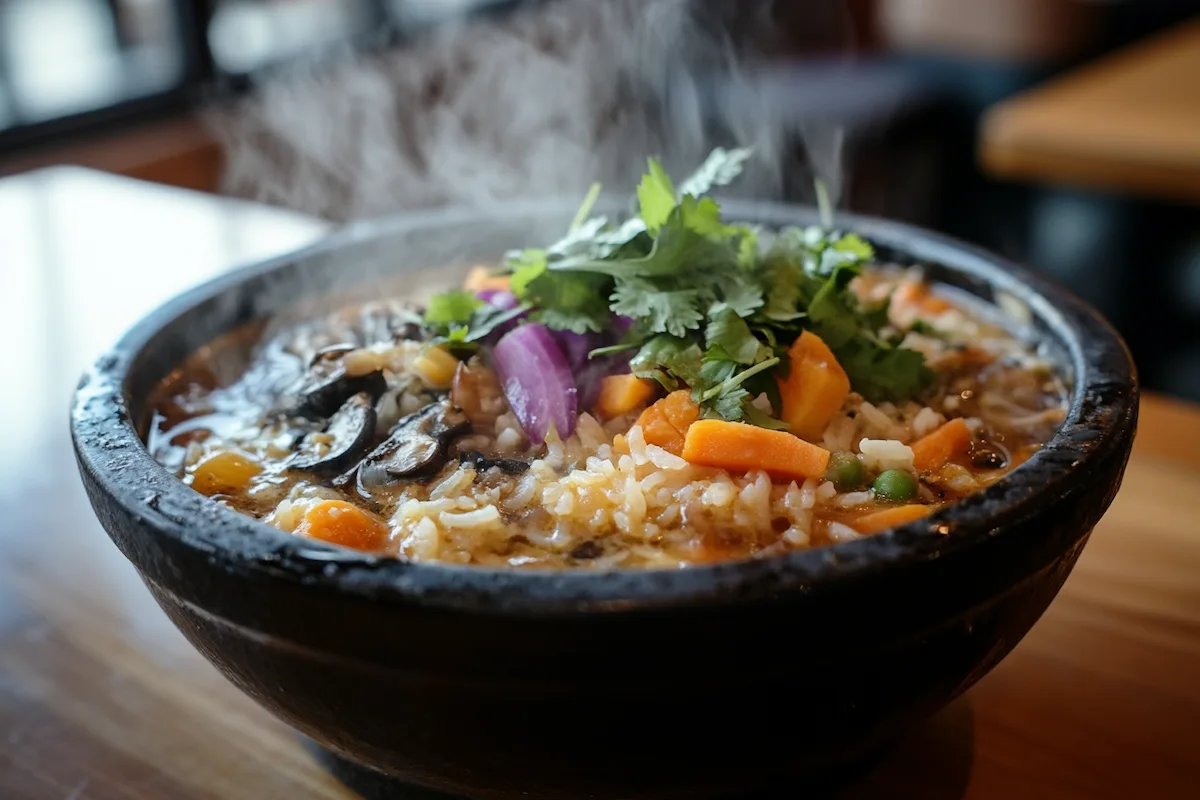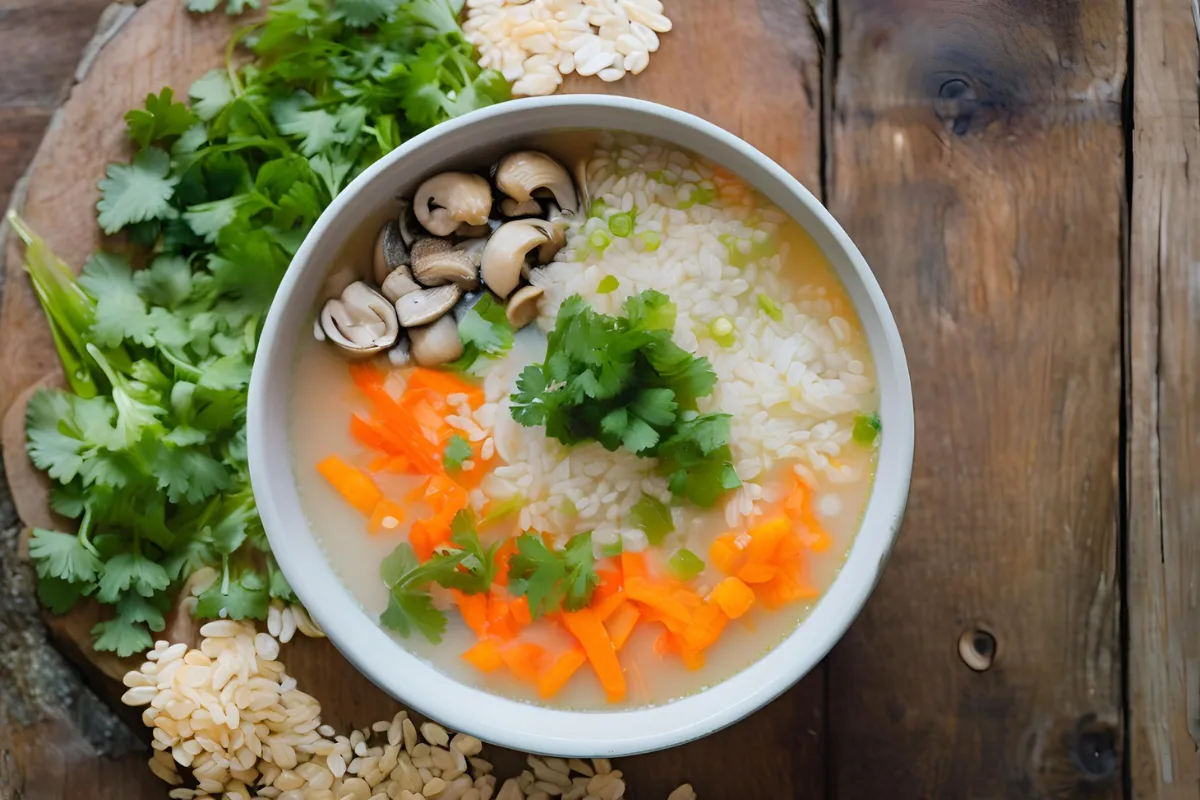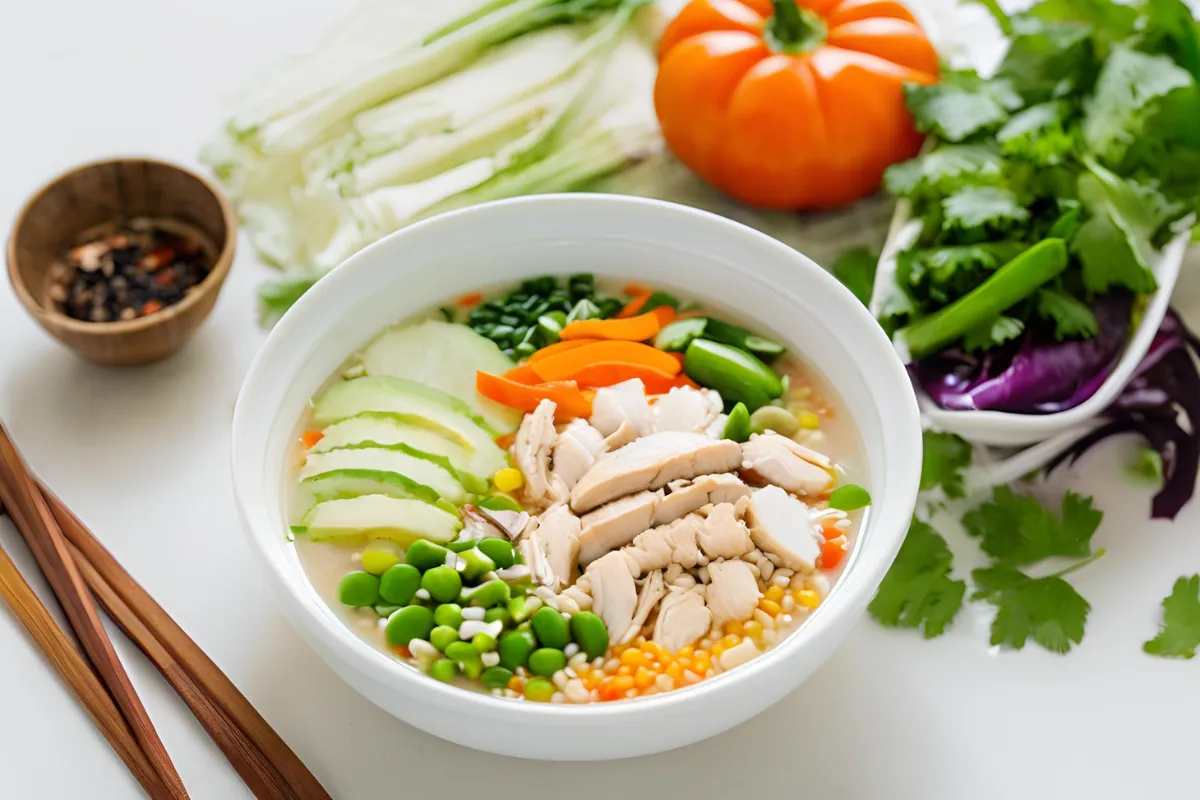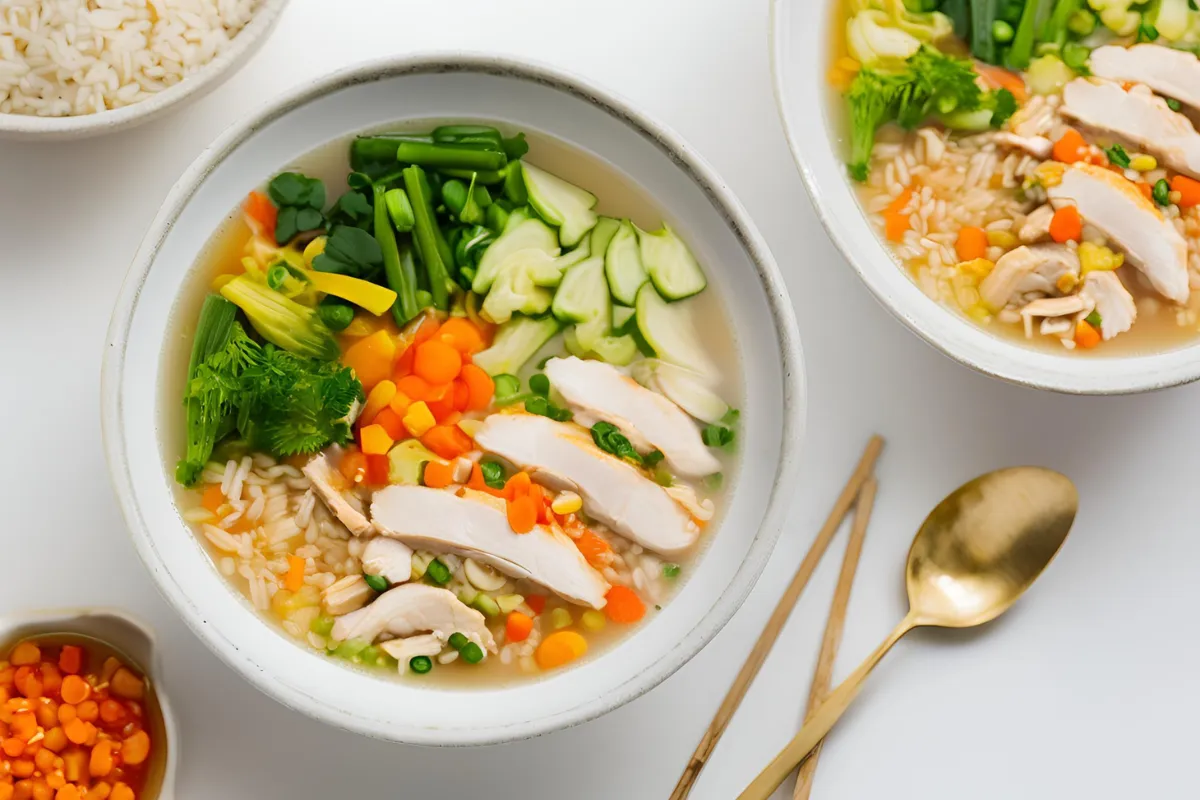Introduction
Sizzling rice soup is a popular dish on many Chinese restaurant menus. The crispy rice sizzles when it hits hot broth. This creates a unique sensory experience with savory flavors. But if you’re watching your calories, you may wonder, how many calories are in sizzling rice soup?
This article will explore its calorie count and ingredients. It will also look at how different variations affect its nutritional content. Whether you’re dining out or cooking at home, knowing the calorie count helps you make healthier choices.
What is Sizzling Rice Soup?
Sizzling rice soup is a savory, aromatic dish. It combines crispy rice with flavorful broth. The dish is typically served with vegetables, proteins like chicken or tofu, and sometimes seafood. When the crispy rice hits the hot broth, it creates a dramatic sizzling effect. This adds both entertainment and comfort to the meal.
The crispy rice adds a satisfying crunch and distinct texture. Traditionally, the rice is fried to achieve a golden crispiness. The broth is light yet flavorful, made with ingredients like soy sauce, ginger, and sesame oil. This balance of hot, crispy, and soothing makes it a beloved dish in Chinese cuisine.
If you’re curious about the calories in sizzling rice soup, it’s important to understand the dish’s components. The ingredients can vary, which means the calorie count can differ depending on how it’s prepared.
Why the Calorie Count Matters
Before we dive into the numbers, let’s talk about why knowing the calorie count of sizzling rice soup is essential. Whether you’re trying to lose weight, maintain a balanced diet, or simply want to be mindful of your nutrition, understanding the calories in what you eat is crucial.
The calorie count helps you make informed decisions about portion sizes and ingredient choices. For example, if you want to limit your calorie intake, choose fewer fried ingredients or switch to lean proteins like chicken or tofu. If you’re not focused on calorie counting and just want a comforting meal, knowing the dish is calorie-dense helps you balance it with other meals throughout the day.
Also, if you’re dining out or ordering sizzling rice soup at a restaurant, calorie information can be handy in deciding whether to choose this dish or something lighter. Now that we understand why the calorie count matters, let’s dive into the specifics of how many calories you can expect to find in this dish!
The Base Ingredients of Sizzling Rice Soup
The first step in determining the calorie count of sizzling rice soup is understanding the ingredients. As with many dishes, the base ingredients are what contribute the most to its overall caloric content. The main ingredients that typically make up sizzling rice soup include the following:
-
Crispy Rice:
The key element of the dish, the rice is fried to create a crispy texture before being added to the soup. Fried rice tends to be higher in calories because the oil used to fry it contributes to the overall calorie count. A serving of crispy rice can add anywhere from 100-150 calories, depending on the amount used.
-
Broth:
The broth serves as the base of the soup, providing warmth and flavor. Typically, the broth is light and may be made with chicken, vegetable stock, or a combination of both. Since broth is often low in calories, it doesn’t contribute significantly to the overall calorie count. However, if the broth is made with added fats like sesame oil or if there’s a rich cream base, it could increase the calorie content slightly.
-
Protein:
Sizzling rice soup usually includes a protein like chicken, pork, tofu, or sometimes shrimp or beef. The type of protein significantly influences the dish’s calorie content. For example, a serving of chicken adds around 100-200 calories, while tofu is generally lower in calories at about 50-100 calories per serving.
-
Vegetables:
Vegetables such as carrots, mushrooms, and bamboo shoots are often included. These are relatively low in calories but add nutritional value and flavor to the soup. You might find that vegetables only add around 50-100 calories to a serving, depending on the amount and variety used.
When combined, the total calorie count of the base ingredients, including the crispy rice, broth, protein, and vegetables, can range between 250-500 calories per serving. But, as you’ll see, this count can change drastically depending on the specific recipe and serving size.
Sizzling Rice Soup Ingredients and Their Caloric Contribution
When we talk about how many calories are in sizzling rice soup, the first thing we need to do is take a closer look at the key ingredients that make up this dish. From the crispy rice that gives it its signature sizzle to the flavorful broth, each ingredient plays a role in determining the overall calorie count. Let’s break it down.
The Base Ingredients of Sizzling Rice Soup
Sizzling rice soup has a variety of base ingredients, each contributing differently to the calorie count. While the crispy rice and broth are the standouts, other ingredients like protein and vegetables also play a part in the dish’s final nutritional profile.
Common Ingredients: Chicken, Vegetables, and Rice
Rice forms the backbone of this soup. White rice is commonly used in sizzling rice soup, and while rice itself isn’t very high in calories, the amount used can add up quickly. One cup of cooked white rice typically contains around 200 calories. When fried to achieve that crispy texture, the oil adds even more calories to the dish.
Vegetables are often added to add color, flavor, and texture to the soup, including carrots, bamboo shoots, mushrooms, and sometimes baby corn or peas. These vegetables are relatively low in calories, with most adding only about 10 to 50 calories per serving. They’re nutrient-dense, offering vitamins, fiber, and antioxidants, so they’re a great way to balance out the higher-calorie ingredients in the dish.
Calories in Common Soup Bases: Broth, Soy Sauce, etc.
The broth is typically clear and light, either chicken or vegetable-based, and it’s one of the lowest-calorie components of sizzling rice soup. A basic, low-fat chicken broth usually contains around 10-20 calories per cup. However, soy sauce—which is often added for flavor—can pack in a bit more sodium and calories. A tablespoon of soy sauce has around 10 calories, but it’s usually used sparingly. If the soup contains any sesame oil or ginger, those could add an extra 20-40 calories per serving, depending on the quantities used.
Sizzling Rice and Its Role in the Calorie Count
Now, let’s talk about the star of the dish: the sizzling rice. The way the rice becomes “sizzling” is by frying it in oil before it’s added to the hot broth. This crispy rice gives the soup its signature crunch and a deep flavor that contrasts beautifully with the delicate broth.
What Makes the Rice “Sizzling”?
The rice gets its sizzling effect when it’s cooked at a high temperature, usually in a wok, and then placed into the hot soup. The moisture in the broth hits the crispy rice and causes it to make that satisfying sizzle. This technique is what gives the dish its name and unique texture.
The Calorie Density of Crispy Rice
Crispy rice is calorie-dense because it is fried. The oil used to fry the rice adds significant calories—typically 100-150 calories per serving. This is a key point to keep in mind, as the rice can sometimes contribute more calories than the broth or protein in the dish. Depending on how much crispy rice is used, the calorie count can easily go up.
How the Rice Impacts the Overall Calorie Count
The crispy rice adds extra calories and plays a significant role in the total calorie content of the soup. While the rice provides that delightful crunch and texture, it also increases the dish’s calorie density. If you’re looking to reduce the calorie count, you could use less rice or opt for a lighter cooking method, like baking the rice instead of frying it.
Protein Sources in Sizzling Rice Soup
Another essential component of sizzling rice soup is the protein, and the choice of protein can greatly affect the overall calorie count.
Chicken, Pork, or Tofu: Calorie Differences
Chicken is the most common protein used in sizzling rice soup, and it’s typically a lean choice. A small portion of chicken (around 3 ounces) adds about 140-200 calories, depending on whether the skin is left on or not. If you’re aiming for a lower-calorie option, skinless chicken breast is the best choice.
On the other hand, pork can be a fattier protein option, adding more calories to the dish. A serving of pork might add around 200-300 calories, depending on the cut and fat content.
For those following vegetarian diets, tofu is often used as a plant-based protein. Tofu is relatively low in calories—about 70-100 calories per 3-ounce serving. It’s also a good source of protein, making it a nutritious addition to the dish without significantly boosting the calorie count.
Lean Proteins vs. Fatty Proteins in the Soup
Lean proteins like chicken breast or tofu are the better options if you want to keep the calories in sizzling rice soup on the lower side. Fatty cuts of meat or pork belly can add up quickly in calories due to the higher fat content, so it’s worth considering what type of protein will suit your dietary goals best.
Vegetables in Sizzling Rice Soup
Vegetables are another important part of sizzling rice soup, adding both flavor and nutritional value to the dish. The good news is that vegetables generally don’t contribute many calories but help make the soup more filling and well-rounded.
Vegetables Often Included: Carrots, Mushrooms, etc.
Carrots, mushrooms, and bamboo shoots are common in sizzling rice soup. These vegetables are rich in fiber and vitamins, and they’re typically very low in calories. For instance, carrots provide about 25-30 calories per half-cup serving, while mushrooms contribute only about 15 calories. Even if you add a whole bunch of vegetables, they won’t drastically increase the calorie count of the dish. In fact, they may even make it feel more satisfying without adding a significant amount of calories.
Low-Calorie Additions to Boost Flavor and Nutrition
In addition to adding low-calorie veggies, you can also incorporate spinach, bok choy, or even water chestnuts, which are commonly used in Chinese soups. These vegetables add even more texture, flavor, and nutritional value without bumping up the calorie content. They can help balance out the rich, crispy rice, making the dish more refreshing while maintaining its complexity.
Variations of Sizzling Rice Soup and Their Caloric Differences
Sizzling rice soup varies widely depending on where it’s made and the ingredients used. Whether you’re enjoying a bowl at your favorite Chinese restaurant or making it at home, many factors influence the calorie content. Let’s explore these variations and see how they impact the total calorie count of this beloved dish.
Traditional vs. Modern Sizzling Rice Soup
Caloric Differences in Recipes Across Restaurants
In traditional Chinese cuisine, sizzling rice soup is a simple dish made with crispy rice, broth, and a few vegetables and proteins. However, modern variations—especially those served at restaurants—often add extra ingredients and richer flavors, which can significantly increase the soup’s calorie content.
For example, some restaurant versions of sizzling rice soup may incorporate seafood, such as shrimp or scallops, which can raise the calorie count due to the higher protein content. A serving of shrimp can add about 100 calories, while scallops might contribute another 150-200 calories, depending on the portion size.
Ingredients That Affect the Calorie Content
In addition to seafood, some restaurant versions might include richer ingredients like heavy cream or extra oils, which make the broth richer and more flavorful, but also significantly increase the calorie content. For instance, a splash of cream could add an extra 50-100 calories per serving, depending on how much is used. Similarly, using a lot of sesame oil or fried garlic in the broth can also boost the calorie count by adding extra fat.
Therefore, if you’re dining out, the calorie count of sizzling rice soup can be much higher than a basic homemade version. Some restaurant servings might contain upwards of 600-800 calories, especially if they include richer proteins or additional fats in the broth.
Serving Sizes and Caloric Impact
The Size of a Typical Serving in Restaurants vs. Homemade
One of the biggest factors affecting the calorie count is the serving size. Restaurant portions of sizzling rice soup tend to be larger than homemade servings, which naturally increases the calorie count. A typical restaurant portion could easily be 2-3 cups of soup, often containing more crispy rice and extra protein, resulting in a total of 600-700 calories per serving.
On the other hand, homemade versions tend to be more controlled in portion sizes. If you’re making the soup at home, you can choose exactly how much rice and protein to add, and you can customize the broth to be lighter by using less oil or opting for a lower-calorie protein like tofu. A standard homemade serving might contain anywhere from 300-500 calories, depending on the ingredients and portion sizes.
How Different Serving Sizes Impact Calorie Intake
The key here is understanding the impact of portion sizes on your overall calorie intake. If you’re mindful of how much rice and protein you use, you can significantly reduce the number of calories in your soup. For example, by cutting back on the crispy rice or using a leaner protein like chicken breast or tofu, you can lower the total calorie count while still enjoying the essential flavors and textures of sizzling rice soup.
It’s also important to note that many restaurant versions of the dish come with additional sides like dumplings or spring rolls, which can easily add another 200-300 calories to your meal. So, if you’re eating out, it’s always a good idea to consider how your side dishes or accompanying foods will impact the overall calorie count.
Calorie Content in Popular Sizzling Rice Soup Recipes
Comparison of Calories in Restaurant Versions
As we’ve seen, restaurant versions of sizzling rice soup are typically higher in calories than homemade versions. On average, a bowl of sizzling rice soup in a Chinese restaurant contains around 600-800 calories. This can vary depending on the type of protein used, whether seafood is added, and how much oil is included in the broth. If you’re ordering a large bowl with extra crispy rice and fatty meats, you could be looking at upwards of 1,000 calories for a single serving!
Homemade Recipes and Their Caloric Breakdown
When making sizzling rice soup at home, you have more control over ingredients and portion sizes. This helps manage calories. A basic homemade version with lean protein like chicken, clear broth, and moderate crispy rice ranges from 300-500 calories per serving. You can also swap fried rice for baked or air-fried rice, significantly lowering the calorie density.
For a lighter version, use tofu as the protein and add more vegetables. Choose a lower-fat broth to reduce calories. This version may have 350-400 calories per bowl. Using less oil when cooking rice or opting for a lighter stock also helps lower the calorie count.
In conclusion, the calorie content of sizzling rice soup depends on preparation, ingredients, and portion sizes. Restaurant versions tend to be higher in calories due to larger servings and richer ingredients. Homemade versions offer more flexibility, allowing for a healthier, lower-calorie dish.
How to Make a Healthier, Lower-Calorie Sizzling Rice Soup
If you love sizzling rice soup but want to cut back on calories, don’t worry—there are plenty of ways to make this delicious dish both healthier and lighter. By substituting certain ingredients, controlling your portion sizes, and choosing better cooking methods, you can still enjoy all the crispy goodness without the guilt. Here are some simple strategies to reduce the calorie count while keeping the essence of this satisfying soup.
Substituting Ingredients for Fewer Calories
The good news is that you don’t have to sacrifice flavor to make your sizzling rice soup healthier. There are plenty of substitutions you can make to cut back on the calorie content without compromising taste.
Lower-Calorie Broths
Traditional sizzling rice soup is made with a flavorful broth that may sometimes be rich in fat. To reduce calories, opt for a low-sodium vegetable or chicken broth instead. These alternatives tend to have fewer calories without sacrificing the deep, savory flavor of the soup. If you’re looking for even fewer calories, you could use a homemade vegetable broth where you control the ingredients and avoid added fats.
Lean Meats
Instead of using fatty cuts of meat like pork or beef, go for leaner options. Skinless chicken breast is an excellent low-calorie protein source that will keep the soup hearty without adding too much fat. For a vegetarian or plant-based version, tofu is an excellent choice, as it’s not only low in calories but also a great protein-packed alternative.
Rice Alternatives
The crispy fried rice is often the culprit behind a lot of the calories in sizzling rice soup. To make a lighter version, consider using cauliflower rice instead of regular white rice. Cauliflower rice has a fraction of the calories and can still provide a similar texture, especially when crisped up. If you prefer to stick with rice, try using brown rice instead of white rice, as it provides more fiber and nutrients, helping you feel fuller for longer.
Portion Control and Caloric Management
Another simple way to make your sizzling rice soup healthier is by adjusting the portion sizes. It’s easy to overeat in a restaurant setting, where portions tend to be large, and this can lead to an unnecessary calorie intake. So, what can you do?
How to Reduce Calorie Intake by Adjusting Serving Size
At home, controlling portion sizes is easy. By making smaller batches or dividing the soup into smaller servings, you can better manage the calories you consume. A typical serving of sizzling rice soup at a restaurant can range from 400 to 600 calories, but making it at home allows you to adjust the amount of crispy rice and broth, significantly reducing the overall calorie count.
If you’re dining out, ask for a smaller portion or share the dish with a friend. This way, you can enjoy the flavors without consuming excess calories. Balance your meal by adding a side of vegetables or a light salad to reduce your total calorie intake while still feeling satisfied.
Tips on Balancing the Soup with Other Low-Calorie Dishes
Pair your sizzling rice soup with light appetizers, like steamed vegetables or a small side salad with a vinaigrette dressing, to create a more balanced meal. This will give you additional fiber, vitamins, and minerals without adding many calories. Avoid fried side dishes, which can add unnecessary calories, and opt for healthier choices instead.
Healthier Cooking Methods for Sizzling Rice Soup
One of the best ways to make sizzling rice soup lighter is by changing how you prepare it. Instead of frying the rice in oil, there are several cooking techniques you can use to lower the calorie content.
Using Less Oil
One of the most straightforward methods to reduce calories in sizzling rice soup is by using less oil to fry the rice. If you must fry it, use a non-stick pan with a minimal amount of oil or opt for an air fryer to get that crispy texture without the added fat and calories. Alternatively, baking the rice in the oven to crisp it up is another great option. This can reduce the amount of oil needed, which cuts down on calories significantly.
Opting for Steaming and Other Techniques
Steaming your vegetables and proteins instead of sautéing them in oil is a healthy choice. Steaming preserves the nutrients in the vegetables and doesn’t require added fats. You can also consider simmering the broth with herbs and spices to boost the flavor without relying on sodium-heavy soy sauce or oils. These changes will significantly reduce the overall calorie content of your sizzling rice soup.
For the broth, consider using a miso paste or herb-infused water to enhance flavor while keeping calories low. These alternatives can still deliver that rich, savory taste you crave without the added calories from oils and sauces.
By making just a few simple adjustments, you can enjoy a healthier, lower-calorie version of sizzling rice soup without losing any of its beloved flavors.
FAQs about Sizzling Rice Soup
Can I make sizzling rice soup with fewer calories?
Yes! You can reduce the calorie count in sizzling rice soup by making a few simple substitutions. Opt for low-sodium broth and use lean protein such as chicken breast or tofu. Additionally, you can substitute cauliflower rice for regular white rice to significantly cut calories while still maintaining that satisfying crunch. Reducing the amount of oil used in frying the rice also helps keep the dish lighter.
What is the healthiest version of sizzling rice soup?
The healthiest version of sizzling rice soup would include a low-fat, low-sodium broth, lean protein like chicken or tofu, and a generous amount of vegetables such as carrots, mushrooms, and baby corn. Using brown rice instead of white rice can also increase the fiber content and make the dish more nutritious. By cutting back on frying the rice and using minimal oil, you can create a version that’s both delicious and nutritious.
Are there vegetarian versions of sizzling rice soup?
Absolutely! A vegetarian version of sizzling rice soup is easy to prepare. Simply replace the chicken or other animal proteins with tofu or additional vegetables. Mushrooms, in particular, work well as a meat substitute because of their umami flavor. Be sure to use a vegetable broth and avoid any meat-based ingredients to keep it fully plant-based.
How does the protein in sizzling rice soup affect the calorie count?
Protein is essential in sizzling rice soup, but the type you choose affects the calorie count. Chicken breast has fewer calories than pork or beef, and tofu offers a low-calorie plant-based option. Choosing leaner proteins helps lower the soup’s calorie count while still providing the necessary nutrients for a satisfying meal.
What is sizzling rice soup made of?
Sizzling rice soup typically consists of crispy fried rice, vegetables (like carrots, mushrooms, and bamboo shoots), a flavorful broth (usually chicken or vegetable-based), and a choice of protein such as chicken, pork, or tofu. The rice “sizzles” when it hits the hot broth, adding a unique texture and flavor.
How many calories are in Korean rice soup?
Korean rice soup, like juk, usually contains fewer calories than sizzling rice soup. It’s often made with brown or white rice cooked in a simple broth with minimal added fats. A typical serving of Korean rice soup ranges from 150 to 250 calories, depending on the ingredients.
Conclusion
Sizzling rice soup is a comforting dish. However, it can be higher in calories than expected. On average, a serving contains 250 to 500 calories. The crispy rice, broth, and protein contribute most to the total. The calorie content varies depending on the protein used, the amount of fried rice, and any added oils.
The good news is that you can make this dish healthier. Start by choosing a low-sodium broth. Use lean proteins like chicken breast or tofu. Swap fried rice for cauliflower rice to cut calories. These simple changes won’t compromise flavor.
Controlling portion sizes is another key to lowering calories. Opt for healthier cooking methods, such as steaming or baking. This helps keep your soup light and nutritious.
If you’re mindful of your calorie intake, these small adjustments make a difference. It’s all about balance. Enjoy your favorite dish while sticking to your health goals. Indulge in the crunch and flavorful broth, knowing you’re making a healthier choice that fits your lifestyle.




